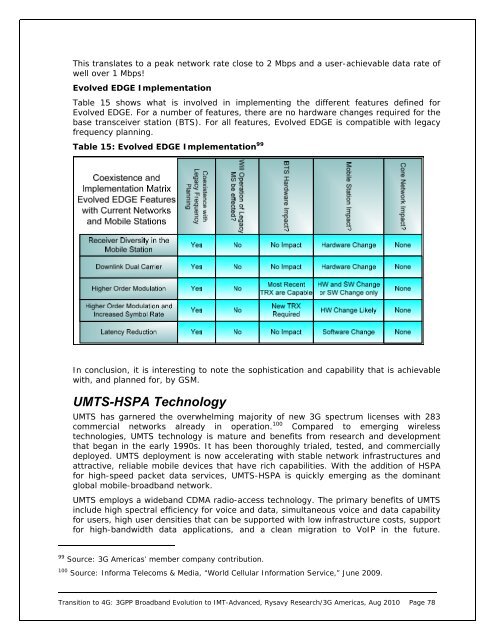3GPP Broadband Evolution to IMT-Advanced - 4G Americas
3GPP Broadband Evolution to IMT-Advanced - 4G Americas
3GPP Broadband Evolution to IMT-Advanced - 4G Americas
- No tags were found...
Create successful ePaper yourself
Turn your PDF publications into a flip-book with our unique Google optimized e-Paper software.
This translates <strong>to</strong> a peak network rate close <strong>to</strong> 2 Mbps and a user-achievable data rate ofwell over 1 Mbps!Evolved EDGE ImplementationTable 15 shows what is involved in implementing the different features defined forEvolved EDGE. For a number of features, there are no hardware changes required for thebase transceiver station (BTS). For all features, Evolved EDGE is compatible with legacyfrequency planning.Table 15: Evolved EDGE Implementation 99In conclusion, it is interesting <strong>to</strong> note the sophistication and capability that is achievablewith, and planned for, by GSM.UMTS-HSPA TechnologyUMTS has garnered the overwhelming majority of new 3G spectrum licenses with 283commercial networks already in operation. 100 Compared <strong>to</strong> emerging wirelesstechnologies, UMTS technology is mature and benefits from research and developmentthat began in the early 1990s. It has been thoroughly trialed, tested, and commerciallydeployed. UMTS deployment is now accelerating with stable network infrastructures andattractive, reliable mobile devices that have rich capabilities. With the addition of HSPAfor high-speed packet data services, UMTS-HSPA is quickly emerging as the dominantglobal mobile-broadband network.UMTS employs a wideband CDMA radio-access technology. The primary benefits of UMTSinclude high spectral efficiency for voice and data, simultaneous voice and data capabilityfor users, high user densities that can be supported with low infrastructure costs, supportfor high-bandwidth data applications, and a clean migration <strong>to</strong> VoIP in the future.99 Source: 3G <strong>Americas</strong>’ member company contribution.100 Source: Informa Telecoms & Media, “World Cellular Information Service,” June 2009.Transition <strong>to</strong> <strong>4G</strong>: <strong>3GPP</strong> <strong>Broadband</strong> <strong>Evolution</strong> <strong>to</strong> <strong>IMT</strong>-<strong>Advanced</strong>, Rysavy Research/3G <strong>Americas</strong>, Aug 2010 Page 78
















